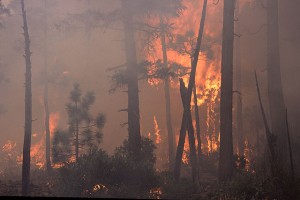Scientists that study plants growing in areas affected by Western wildfires are noticing that the types of plants that replace the old burned-over varieties are different than the plants that were originally there, according to research published recently in the Journal of Ecology. The new plants are generally those that are more adapted to warmer, more open microclimates, and are ones more commonly seen at locations closer to the equator, speeding up the process of plant migration due to a warming climate.
Capital Public Radio reported here that this shows the importance of thinning forests to keep trees in the area by removing the chance of burning up the entire canopy, since those trees provide shade that make the transition to a different ecosystem slower.
Takepart.com extended this study here to show the possible implications of changing local climate on agriculture. They suggest that in a warmer climate, the range of temperatures any location experiences will affect the types of crops that can be grown. For example, in some developing countries, potatoes (which like cool temperatures and thrive at higher elevations such as in South American in the Andes) will no longer be a viable crop and farmers may have to switch to bananas or plantains.
